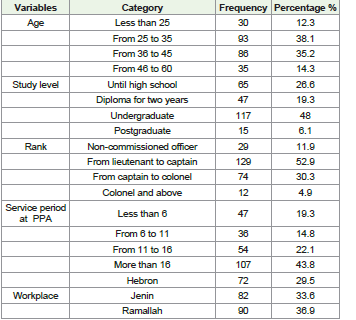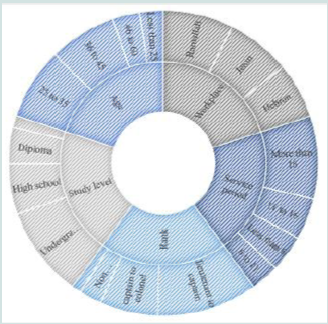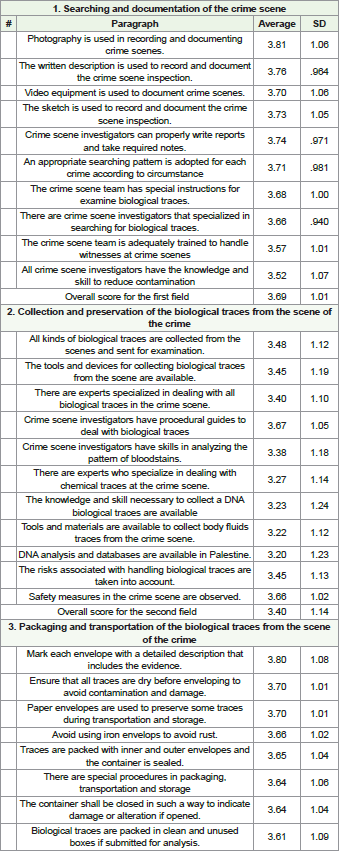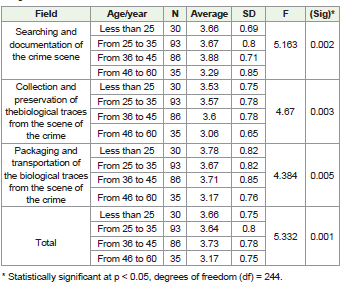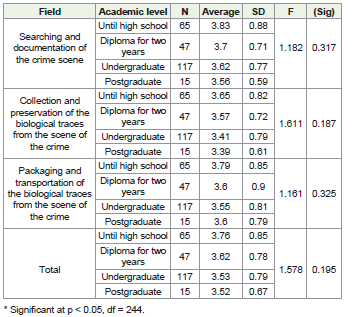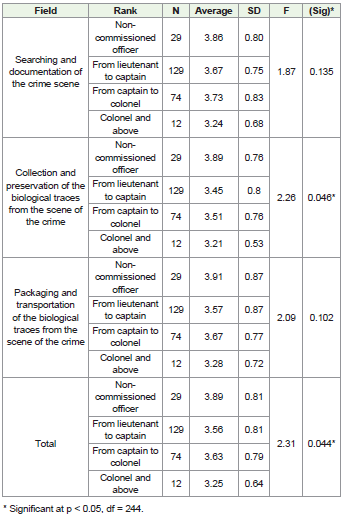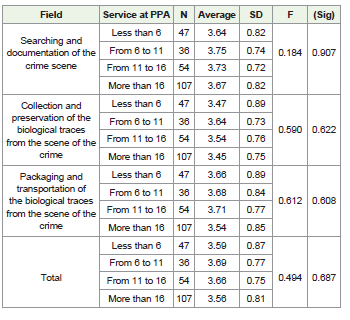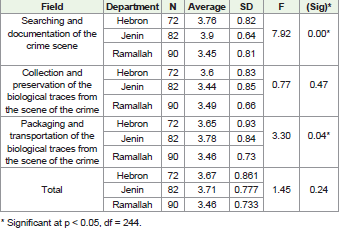Journal of Forensic Investigation
Download PDF
Research Article
Level of Experiences in processing of Biological Forensic Traces at the Crime Scene among Palestinian Police Employees
Khalilia WM1* and Rabaia AM2
1Forensic Science Department, Al Istiqlal University, Jericho, Palestine.
2Law and Police Sciences Department, Al Istiqlal University, Jericho, Palestine.
*Address for Correspondence: Khalilia WM, Forensic Science Department, Al Istiqlal University, Jericho,
Palestine. E-mail Id:khaliliawalid@gmail.com
Submission:20 January 2024
Accepted:22 February 2024
Published:24 February, 2024
Accepted:22 February 2024
Published:24 February, 2024
Copyright:©2024 Khalilia WM, et al. This is an open-access article
distributed under the Creative Commons Attribution License, which
permits unrestricted use, distribution, and reproduction in any medium,
provided the original work is properly cited.
Keywords:Crime Scene Investigators; Forensic Science; Biological Traces; Bloodstains; DNA
Abstract
Crime Scene Investigation (CSI) means taking all lawful methods,
processes and procedures that lead to solving crimes and detecting
the truth.This study aimed to evaluate the Palestinian Police
Agency (PPA) employees’ perceptions towards the experiences
in the documentation, collection, preservation, packaging and
transportation of biological traces from the scene of crime. An
item-based questionnaire was designed with this aim in mind, and
its reliability as well as validity were tested. The study’s target group
included (244) PPA-affiliated crime scene investigators and officers
who served in the governorates of Hebron, Jenin, and Ramallah
during summer of 2022. The majority of respondents expressed
agreement or neutrality regarding the technical procedures used at
the crime scene. In general, PPA employees have positive experiences
with the preservation, documentation, collection, packaging, and
transportation of biological evidence from the scene. The study’s
findings make it abundantly evident that the average for each
paragraph was greater than (3.57), demonstrating that PPA personnel
working at the crime scene generally had sufficient experience
handling forensic traces. However, preservation and collection of
biological traces especially DNA sources from the crime scene were
the lowest with a total averages of (3.40). While the searching and
documentation of the crime scene section, and the packaging and
transportation of the biological traces from the scene of the crime the
total averages were (3.69) and (3.62) respectively.
In addition, there was a significant difference (P < 0.05) between the respondents regarding to the three working places, age, and ranks. This study recommending the decision makers in Palestine to pay attention to the technical procedures at the crime scene and employ a trained team that has sufficient knowledge and skills to deal with biological forensic traces at the crime scene. This study also recommends conducting deeper analytical studies to include all departments and entities working at crime scenes in all governorates in Palestine.
In addition, there was a significant difference (P < 0.05) between the respondents regarding to the three working places, age, and ranks. This study recommending the decision makers in Palestine to pay attention to the technical procedures at the crime scene and employ a trained team that has sufficient knowledge and skills to deal with biological forensic traces at the crime scene. This study also recommends conducting deeper analytical studies to include all departments and entities working at crime scenes in all governorates in Palestine.
Introduction
Sydney declaration about principles of forensic science, states that
activity and presence produce traces that are fundamental vectors of
information, and Crime Scene Investigation (CSI) is a scientific and
diagnostic endeavor that requires scientific expertise[1]. The process
of dealing with a crime scene is time-consuming and laborious. It
entails carefully recording the scene’s circumstances and gathering
any tangible evidence that can shed light on what transpired and
identify the perpetrator [2-4]. It is not sufficient to only use scientific
tools to analyze traces at a crime scene; one should also consider
behavioral factors. Investigative psychology is a valuable tool for
resolving investigative issues[5].
CSI is a systematic scientific process that begins with receiving
a report about the crime occurring and moving the nearby first
officer to the crime scene. This is followed by several procedures that
begin with preserving the crime scene by securing and protecting
it. Then complete the basic legal procedures. These followed by
several necessary operations, such as documenting the crime scene,
searching for forensic evidence, documenting, collecting, packaging,
labelling, and then carrying it properly to the criminal laboratories
for analysis purpose[6-9]. Preserving, analyzing, interpreting, and
reconstructing all pertinent physical evidence at a crime scene are
crucial CSI techniques. These need for a very high level of accuracy.
As a result, processing a crime scene is considered as a vital aspect
of an effective forensic investigation [10-12]. Nowadays, reports
of serious sever; dangerous and significant crimes are growing. In
addition, new trends in crime patterns are emerging virtually daily,
making criminal activity more complex. Recently there is attentionto
CSI all over the world. Unfortunately, in Palestine narcotic drugs,
assault, rape, theft, violence against women and children and various
other crimes are on the increase. Theft (57.3%), assaults (19.6%),
harassment or assault by Israeli military or settlers (11.8%), property
damage (4.8%), and attempted robbery (3.6%) are the most common
crimes against people [13]. In 2022, the Palestinian Central Bureau of
Statistics (PCBS) reports that the number of criminal offenses in the
studied areas in the West Bank in Palestine per 100,000 population
were (1909) in Jenin, (1366) in Ramallah and (740) in Hebron [14].
The criminal cases accumulated in front of the Palestinian judiciary
are so much and this needs conclusive evidence to resolve them.
In Palestine, the legal authorities designated by statute with the
authority to investigate crimes, search, record, and preserve crime
scenes are the ones who are granted judicial police status by the
legislation. Within the structure of the Palestinian Police Agency
(PPA), there is a general directorate for forensic evidence and criminal
laboratories, which divided into forensic laboratories, fingerprints,
cybercrimes, and CSI departments. This structure also contains the
General Directorate of Criminal Investigation and the Criminal
Research Directorate. In the newly established criminal laboratories
department, there is documents, firearms, chemical and biological
examination sections. The Palestinian Ministry of Justice resorts to
conducting some examinations of biological evidence such as DNA
profiling in private laboratories in Palestine or abroad due to the lack
of all capabilities to conduct such examinations (The administrative
affairs at the PPA command, personal communication).
Biological evidence is a kind of physical evidence with any
tangible object of biological origin -not always visible to the naked
eye- can be subjected to DNA testing, and routinely used in criminal
proceedings that can connect a person to a crime scene [8]. At crime
scenes, biological forensic traces are searched for due to their
importance in criminal investigations. The source of these traces left
by the suspect or from another source such as the victim or curious
people. Biological forensic evidence includes bloodstains and other
body fluids and tissues such as saliva, semen, vaginal secretions, sweat,
urine, vomitus, feces, and other body residues such as hair, bones and
nails. Biological evidence also includes latent print evidence, such as
fingerprints, lip prints, and ear prints. Plant remains, insects, pet hairs,
or seeds are examples of biological evidence that can be discovered
at the crime scene. In addition to the viral and microbiological
organisms [8,15]. Potential sources of biological traces can include,
but are not limited to, the door handle of the house, refrigerator, on
the personal objects such as underwear, a cigarette cone, weapons,
eyeglasses, hat, masks, cotton, swaps, toothpick, stamp, envelope,
used condoms, bottle, can, glass, blanket, pillow, sheet, fingernail.
Building furniture, rooms, walls, doors, windows, drawers, vehicles
etc. in the crime scene. With the purpose of identifying the perpetrator
and solving the crime through the scientifically examine and analyze
these biological traces in the forensic labs, by extracting DNA from
the cells or fingerprints from the skin [16,17].
Biological evidence requires special storage, preservation
and transport conditions as it is more susceptible to damage and
contamination than other evidence at the scene of crime. Blood and
other body fluids are exposed to contamination with bacteria and
other organisms, which exposes them to damage, DNA degradation
and mixing it with other sources of DNA [18]. Therefore, the crime
scene team should be trained, skilled and well equipped with the
necessary tools and equipment. In order to handle such evidence
in terms of preserving, collecting, storing and transporting it
appropriately to prevent damage and contamination of this biological
evidence. The question of this study is PPA employees ready to handle
the biological evidence in the crime scene. In Palestine, crime scene
investigation has never been studied before. Therefore, this study is
the first attempt to look at the criminal investigations in the crime
scene at Palestine, in terms of determining the structure that governs
the work of the PPA and revealing the level of skills and capabilities
available to those working in this field.
Methodology
Study sample:
This survey was a cross sectional descriptive study,simple random
sampling was used to obtain the facts.The perceptions of (244) crime
scene investigators and employees serving in CSI at the north, south
and middle of Palestine were assessedduring summer of (2022). From
which (72)serving inHebron, (82) in Jenin, and (90)in Ramallah
governorates.Study tool:
A comprehensive online search was done, and information
from a literature review[19,20] was used to create an item-based
questionnaire that was used as a tool to assess the experiences of
PPA employees and crime scene investigators regarding the technical
procedures used at the crime scene. The initial questionnaire was
peer reviewed by four faculty staff members to ensure the content
validity of it. The final form of the questionnaire was consisted two
sections of (39) paragraphs. From which the first section composed
from (5) questions personal and demographic variables.The second
section contained 34of (5-point Likert scale)closed questions items,
were grouped into searching and documentation of the scene (10)
paragraphs, preservation and collection of biological evidence from
the scene (11) paragraphs, and packaging and transportation of traces
from the scene (13) paragraphs.Statistical analysis:
Statistical Package for Social Sciences (SPSS) was used to analyze
data from the (224) statistical population. Average and frequency
were reported, analysis of variance and t‑test were used, and the
significance level was set at P<0.05.Results
This study was conducted to assess the Palestinian police
employees’ perceptions towards the experiences in the technical
procedures used in the crime scene such as documentation, collection,
preservation, packaging and transportation of biological traces from
the scene in three governorates in Palestine. Data collected from
(244) respondents from PPA, working in CSI were analyzed with a
response rate of 95.5%.
Personal data analysis:
Respondents’ demographic and personal parameters were
evaluated as shown in (Table 1). The studied attributes included;
the respondents’ age, working places, study level, rank, and
number of years serving in the PPA. Analyzed data indicates that
most of PPA employees are young, (73.3%)of them ranging from
(25 to 45) years old.Concerning the respondents’ level of study, it was found that
the majority of them (48%) held bachelor’s degree. While (26.6%)
until high school, (19.3%) diploma, and (6.1%) had postgraduate
certificates. Data analysis also shows that the participants consisted
of (19.3%) had served at the PPA for less than six years, (14.8%)
had served between (6 to 11) years, and (22.1%) had served
between (11 to 16) years. While (43.8%) had worked for more than
(16) years (Table 1), (Figure 1).
According to the PPA employees rank, (11.9%) of the
respondents holding less than non-commissioned officer rank,
(52.9%) of the respondents ranks from lieutenant to captain
and (30.3%) were from captain to colonel, while (4.8%) of the
respondents were colonel and above. According to the working
district, among participants, (29.5%) of the respondents were
worked in Hebron, (33.6%) in Jenin and (36.9%) in Ramallah
governorate as shown in [Table 1] and [Figure 1].
Figure 1: Pie chart showing the percentage of the respondents according to
the sociodemographic profiles
Table 2: Descriptive statistical analysis of data collected from the Palestinian
police employees included in this study, regarding the technical procedures
followed at the crime scene.
in dealing with chemical traces, body fluids traces, DNA biological
traces and DNA analysis at the crime scene were the most relatively less
experiences from the PPA employees point of view [Table 2] .While
the first and the third sections “searching and documentation of the
crime scene“, and “packaging and transportation of the biological
traces from the scene of the crime“, the total averages were (3.69)
and (3.62) respectively. Results also show in these two sections that all
paragraphs’ average were more than (3.5) except paragraph number
(34) about the refrigeration methods are used to preserve some traces
during transportation and storage, the average was (3.38)
[Table 2] .
Data Analysis of the Studied Sociodemographic Profile:
The study’s participants’ responses were examined based on
their demographic information, including their age, educational
background, position, duration of employment with the PPA, and
site of employment; the results are shown in tables (3-7).It is clear from [Table 3] , that there is a significant difference (P
< 0.05) among the averages of the responses according to the age
variable. It was found that the average of the category from (46 -60)
years old was the least agree with the experiences of PPA employees
in technical procedures followed at crime scene with average of (3.17)
compering to other categories.
It is clear from the results that the significance level is greater
than (P = 0.05), so there are no statistically significant differences
between the averages of the responses of PPA employees according to
the study level variable. In the three fields of technical procedures at
crime scenes and in the overall field [Table 4] .
It was found that there is a significant difference (P <0.05) between
the responses of PPA employees towards the experiencesin the fields
of collection and preservation of the biological traces from the scene
of the crime, and in the overall fieldof technical procedures at crime
scenes due to the employeerank variable. The highest averages were
for the higher ranks and the lowest for the lower ranks [Table 5].
It is clear from [Table 6] that the results support the hypothesis
that there is no significant differences (P < 0.05) between the averages
of PPA officer’s responses according to number of serving years in the
all fields of technical procedures used at crime scene.
It is clear from [Table 7], that there is a significant difference (P <
0.05) among the averages of the responses in the fields of searching and
documentation of the crime scene, and packaging and transportation
of the biological traces from the scene of the crime according to the
workplace variable. It was found that the average of the responses
from Ramallah governorate was the least experiences compering to
responses from Jenin and Hebron districts.
Table 3:Average, standard deviations (SD) and ANOVA analysis of technical
treatments followed at the scene of the crime from PPA employees according
to age.
Discussion
The main purpose of this study is to highlight the PPA employees
experiences in technical procedures related to the biological forensic
traces at the crime scene.
The findings of this study demonstrated that the level of overall
experience of participants regarding CSI was adequate, as the average
for all paragraphs was (3.57). Although,The participants in this study
claimed that they have good and sufficient experiences in searching
and documentation of the crime scene procedures, and the packaging
and transportation of the biological evidence from the crime scene
with the total averages of (3.69) and (3.62) respectively. However, the
collection and preservation of biological evidence especially DNA
Table 5:Averages, SD, and ANOVA analysis of technical treatments followed at
the scene of the from PPA employees according to rank.
Table 6:Averages, SD and ANOVA analysis of technical procedures followed at
the scene of the crime from PPA employees according to service period.
Table 7:Averages, SD, and ANOVA analysis of technical treatments followed at
the scene of the crime from PPA employees according to workplace.
sources from the crime scene were relatively insufficient. This is
consistent with knowledge that gives specificity to the circumstances
of collecting and preserving biological evidence at crime scenes [8,
15]. DNA analysis laboratories were recently established in Palestine,
and efforts are still being made to rehabilitate the laboratories with
the necessary equipment and train experts on dealing with biological
evidence for the purpose of DNA analysis. While other laboratories,
such as fingerprints, forgery, ballistic, and some chemical analyses,
have been in existence since 2016 and their staff have been subjected
to adequate courses and training.
In a previous study conducted by the authors of this research, in
order to identify the challenges facing PPA employees serving in the
crime scene. They concluded that there are many challenges facing
Palestinian police officers while managing crime scenes,and clearly
indicate that the legal, administrative, security issues, the need of
equipment and training were the highest challenges. In addition to
the Israeli occupation, which hinders the movement of officers in the
scene of crime [21].
The results of this study demonstrated that the distribution
of participants according to the governorate where they work is
consistent with the real numbers of CSI employee in each district.
The results show that most of the officers working at the crime scene
are young(25-45) years old, holdingundergraduate degrees, and rank
from lieutenant to captain (Table 1).This distribution is mirroring
that of officers in all Palestinian security forces[22].
It is also clear from the results of this study that the most of police
officers’age ranging from (25) to (45) years old. This is due to several
reasons, including the recent formation of the Palestinian security
services, including the PPA, about (30) years ago. Therefore, most of
those affiliated with the security services, especially the police agency,
are still young. In addition, a large number of employees in the security
services have been referred to retirement. These reasons also explain
the high percentage (43.8) of study sample members with more
than (15)service period in the PPA(Table1). The results show that
a high percentage reached(53%) of respondents work at the rank of
lieutenant to captain in the PPA. This is in contrast to the fact that the
PPA recently moved towards recruiting new members, who studied
and graduated from the Police Academy in Egypt and some of whom
graduated from Al Istiqlal University in Palestine, which recently
established a new department specializing in forensic science[13]. It
is also clear from [Table 1] that the number of police officers who
hold an under graduate’s degree is higher, as their percent in the study
sample reached (48%), compared to those who hold a diploma or
postgraduate degree. This is due to two reasons, that the majority of
the new recruits to the police force in the officer category are graduates
of police colleges that grant their graduates anundergraduate’s degree
in law and police sciences. In addition to the motivation towards
the study level rising within the general mood of police salaries as it
distinguishes them positively. Therefore, the recruits seek to complete
their education and obtain anundergraduate’s degree. also as a result
of the lack of job opportunities in fields that depend on academic
degrees, which provides an increased turnout of certificate holders
to join the ranks of the police, as well as the motivation of personnel
for promotion. as well as the fact that the administrative authorities
do not usually oppose completing the educational path for their
affiliates, and this instead of the general Palestinian social mood who
honors holders of academic degrees [21].
Conclusion
For the first time, PPA employees’ experiences in CSI
processing have been assessed successfully in Ramallah, Jenin and
Hebron governorates in Palestine. Various technical procedures
such as preservation, documentation, collection, packaging and
transportation of biological traces from the scene of thecrime were
estimated to assess the experiences of PPA employees in other
governorates in the West Bank, Palestine.
The mean of the respondents’ experiences in studied CSI
procedures were (3.57). Which clearly indicates that PPA officers
at crime scenes, in general handle forensic evidence well. However,
there is a weakness in the preservation and collection of biological
evidence, especially DNA sources traces. In addition, there was a
significant difference between the respondents regarding to the
serving governorate, rank and age.
Focusing on training crime scene investigators from PPA on
dealing with forensic evidence, especially biological evidencefor all
officers and individuals from all Palestinian governorates in which they
serve were recommended. This research holds significance in raising
awareness and knowledge about dealing with biological evidence at
crime scenes among PPA employee, and the results can serve as a
reference point for future studies.Additionally, Future studies will
delve deeper into the nature of the questions used in the study tool,
along with conducting interviews with those involved in dealing with
crime scenes in Palestine. In addition, expanding the study region to
include all Palestinian governorates were recommended.
Conflicts of interest:
The authors declare no conflicts of interest.

